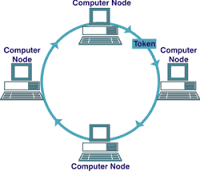



A bus network consist a single central cable(backbone) to which all computer and devices connected
On a ring network, a cable form a closed loop with all computers and devices arranged along the ring
All computers and other devices on a network connected to central device(hub/switch) thus forming a star.
This network transmits data,instruction and information as a single series of signal on both direction and only intended recipient receive it and the rest will ignore it
Data transmits along the ring network travel from a device to another device in one direction until it reach their destination using a token.
In star network, data, instruction and information travel form one node to another node by passing through hub/switch.
▸ It is easy to set up, handle, and implement.
▸ It is best-suited for small networks.
▸ It costs very less.
▸ In comparison to a bus, a ring is better at handling load.
▸ The adding or removing of network nodes is easy, as the process requires changing only two connections.
▸ The configuration makes it easy to identify faults in network nodes.
▸ Due to its centralized nature, the topology offers simplicity of operation.
▸ It also achieves isolation of each device in the network.
▸ Adding or removing network nodes is easy, and can be done without affecting the entire network.
▸ The cable length is limited. This limits the number of network nodes that can be connected.
▸ This network topology can perform well only for a limited number of nodes. When the number of devices connected to the bus increases, the efficiency decreases.
▸ It is suitable for networks with low traffic. High traffic increases load on the bus, and the network efficiency drops.
▸ The failure of a single node in the network can cause the entire network to fail.
▸ The movement or changes made to network nodes affect the entire network's performance.
▸ Network operation depends on the functioning of the central hub. Hence, central hub failure leads to failure of the entire network.
▸ Also, the number of nodes that can be added, depends on the capacity of the central hub.
▸ The setup cost is quite high.
